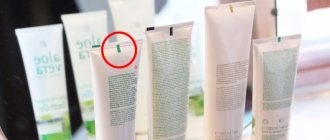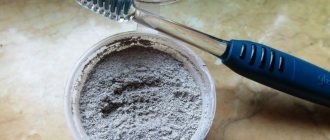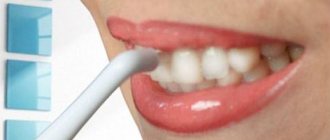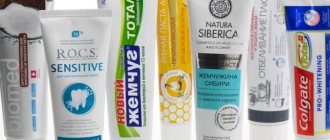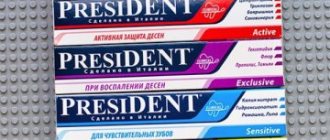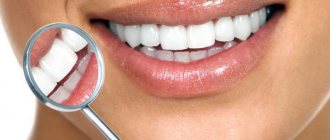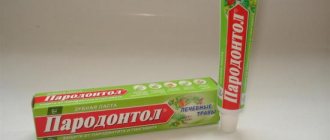Without fluoride? With calcium? With medicinal herbs or whitening? If you are tormented by the question of how to choose toothpaste, this article is for you. In it, “Just Ask” cleans the tubes of myths and teaches you to show your teeth to cunning marketers.
Let’s not bog down with theory and focus all our attention on the main components of toothpastes. We tell you what you need to know about each of them, which ones you should look for in the composition, and which ones you should avoid.
Calcium
Why is it needed? During childhood, as the tooth develops, it takes calcium from food and vitamins. Adult teeth stop receiving calcium in this way. You can take vitamins as much as you like, but if you are not a child or teenager, your teeth will not become stronger. They are already fully formed. The only way to saturate your teeth with calcium is topically, through the enamel. That is, literally smear your teeth with calcium paste.
What does the advertisement say? Calcium is often chosen as the protagonist of packaging.
What the research says. The Department of Pediatric and Preventive Dentistry at the University of Belgrade applied calcium phosphate to damaged enamel and studied the effect. The study showed that under the influence of calcium, surface enamel defects are reduced. This proves the effectiveness of using toothpastes enriched with calcium.
How to be. Look for calcium glycerophosphate in pastes.
Fluorine
Why is it needed? Fluoride prevents tooth decay. Therefore, in populated areas it is even specially added to water.
What does the advertisement say? Manufacturers do not add fluoride to some toothpastes and emphasize this on the packaging. Possible reason: an excess of fluoride can lead to fluorosis - light spots will begin to appear on the teeth.
ROCS boasts that the paste is fluoride-free, so you can squeeze half a tube onto your brush at a time and not be afraid of fluorosis
What the research says. In fact, the concentration of fluoride in pastes is not so high as to cause fluorosis. However, if there is enough fluoride in drinking water, then there is no need for an additional source.
How to be. Find out what the concentration of fluoride is in water in your region. The norm of fluoride in drinking water is 0.7 mg per liter. In 16 out of 166 studied settlements in Russia, the fluoride content in water is increased. If you live in one of them, it is better to use toothpaste with calcium, but without fluoride.
A little history
The first statements that fluoride is good for teeth, as well as that it should be added to drinking water to prevent dental disease, were made by a certain doctor - Gerald Cox (Melon Institute, Pittsburgh, Canada)
Francis Freri, in turn, was very concerned about the negative impact of fluorides on the health of plant workers, as well as the pollution of the air and nature in the vicinity of the aluminum smelters.
It should be noted that the Melon Institute was the main defender of the metal processing industry and, of course, for all its large companies. It is no coincidence that it was from the researchers of this institute that this proposal came.
At that time, from the mid-50s to the mid-60s, there were so many lawsuits related to health harm caused by fluoride alone (than 20 other pollutants combined) that companies urgently needed protection from the enormous amount lawsuits. And a solution to the problem was found. A theory was invented that was supposedly based on actual research that fluoride was good for your health!
One of the defenders of the theory of fluoridation was one of the most influential and famous physicians , with unquestioned authority among those in power - Harold Hodge. Hodge was responsible for numerous works in support of the water fluoridation program and its implementation by 1957.
Today it became known that it was Hodge who was one of the organizers of research and experiments on the effects of radiation on human health after inoculation with plutonium.
So what's the connection?
The most direct one. Harold Hodge served as chief toxicologist on the Manhattan Project.
The project was launched with the goal of developing an atomic bomb, which was subsequently dropped on Jeroshima and Nagasaki. Hodge conducted research on the toxicity of various chemical reagents that were components of the atomic bomb, and the main problem was precisely fluorides; they were used in incredible quantities in the creation of atomic weapons.
In the discovered documents, the book's author, Bryson, saw records that Hodge was given an assignment to provide information to help the government and army defend against lawsuits that were related to personal injury. All information used against the army must be destroyed.
If the dangers of water fluoridation were recognized, then absolutely all organizations that worked with fluoride would be subject to countless lawsuits. Even the US government and military, including the Nuclear Energy Commission. Naturally, Harold Hodge would in no way frame these influential organizations.
Dr. Keyhoe, a famous physician and promoter of the theory of fluoridation , has published large scientific works on the benefits of fluorides.
These works were sponsored by:
Aluminum Company of America (ALCOA), Aluminum Company of Canada, DuPont, Fuel and Lubricants Research Institute of America, Reynolds Metals, United Steel, Kaiser Aluminum, National Institute of Dental Research (NIDR).
In Dr. Keyhoe's personal notes, you can find information about cooperation with the Fluoride Legality Committee, to which Dr. Keyhoe provided materials to defend against fluoride-related lawsuits from corporate clients (see list above).
In addition, none other than Sigmund Freud’s nephew, PR’s father, Edward Bernays, helped sell fluorides to the entire nation.
Edward Bernays was a true professional in the field of creating attractive images for harmful products. Edward was a good psychologist, and conducted research on managing the human mind, and more precisely, managing society. He even published the book “Propaganda”.
While promoting fluoridation, Bernays also took part in promoting cigarettes . Invited to NIIOS to help promote fluoride to the nation, Bernays worked to convince dentists that fluoride was good for teeth. Then the already treated dentists themselves “sold” fluoride to everyone else.
For decades, propaganda in favor of fluoride has been carried out among the population . Scientists who openly stated that fluoride was harmful to the human body were persecuted, ridiculed in the press, or fired from their jobs.
Only today scientists have the opportunity to publish research results that talk about the dangers of fluoride, even in doses allowed by standards.
Widely advertised toothpastes (“Blend-a-med”, “Colgate”, “Aquafresh”, etc.) contain fluoride in fairly large quantities. People buy these toothpastes because of repeated lies in advertising.
So what should we do now?
First, look at this issue with different eyes. Following common sense, we must understand that we should not take (especially regularly) any substances if we do not understand what the substance is.
Even if slight doubts creep in that fluoride can be harmful, it means there is no point in using it. In our case, numerous materials convince us that it is better to abandon it.
Tips from dentists for “fluoride-free” caries prevention:
- The less often we eat food rich in white sugar, the less acid the bacteria will produce.
- It is advisable to consume sugar only in whole foods - nuts, fruits, dried fruits. Even more harmful than white sugar is a genetically modified sweetener (aspartame).
- Reduce the amount of time sugar remains in your mouth. After eating a meal rich in sugar, you should brush your teeth or rinse your mouth.
- It is also harmful to suck sweets in the mouth and drink sugary drinks for a long time. If you drink sweet water, you should immediately brush your teeth.
- It is necessary to brush your teeth thoroughly and often, both with floss and a brush.
Additional Information:
Countries that have banned water fluoridation:
Germany, Austria, Switzerland, Holland, France, Belgium, China, Czech Republic, Denmark, Finland, Hungary, India, Israel, Japan, Luxembourg, Norway, Scotland, North. Ireland, Sweden.
The pineal gland is the first to be hit by fluoride.
It was not until the early 1990s that research began to be conducted on the effects of fluoride on the pineal gland. The pineal gland, or pineal gland, is a small gland that is located between the two hemispheres of the brain.
The pineal gland regulates the release of melatonin, the “youth” hormone , which in turn helps regulate the achievement of puberty . Melatonin is produced by the pineal gland from serotonin, a substance that scientists suggest affects human mental function.
It is also very important that the pineal gland is responsible for immunity , and when it functions normally, it protects the body from the harmful effects of free radicals on the brain.
The initiator of this study, doctor Jennifer Luke (University of Surrey in England), proved that the pineal gland is the first to be affected by fluoride. According to research, excessive amounts of this element in the pineal gland lead to serious dysfunctions and provoke early puberty, and the body’s ability to fight free radicals also decreases.
Research shows the dangerous effects of fluoride on the fetus during pregnancy. Fluoride can cause genetic changes in the fetus, thereby increasing the risk of cancer. Recent studies have shown that fluoride can cause bone cancer.
The worst thing is that almost no one pays attention to these facts. Think about what would happen to the industry if everyone knew about the toxicity of fluoride and its harmful effects on our health!
Fluoride compounds have the most significant effect on the thyroid gland
Research data from scientists shows that thyroid diseases began to increase just at the time when the benefits of fluoride began to be promoted . It is known that the thyroid gland in the body is responsible for many processes related to metabolism.
Violation of its work leads to serious consequences for a person, one of which is obesity . It is no coincidence that the popularization of fluoride in the United States has led to the country's population becoming fatter. Scientists have tracked the relationship between these processes.
Excess fluoride in the body can destroy bones, teeth and the pineal gland
Long-term use of fluoride can lead to genetic damage to DNA, cancer, obesity, low IQ, lethargy, Alzheimer's disease and many other diseases.
Almost all toothpastes contain fluoride. Since childhood, it has been drilled into our memory that we need to brush our teeth twice a day.
The effect of fluoride on the thyroid gland is not all.
Fluorine, actively reacting with aluminum , which is widely used in the manufacture of tableware, forms aluminum fluoride, which can overcome the blood-brain barrier.
The blood-brain barrier protects our brain from harmful substances. Aluminum fluoride penetrates through it and is deposited in nerve cells. The consequences of this compound for the brain can be catastrophic.
This includes dementia and a number of mental and nervous disorders. Studies by some independent scientists have shown that cases of Alzheimer's disease have increased significantly since the popularization of fluoride. Therefore, it is not surprising that the United States is one of the leaders in the incidence of Alzheimer's disease, since fluoridation is used especially widely in this country.
From the Chemicals Handbook:
Sodium fluoride is a synthetic component in the form of white crystals. It is used as an antibacterial agent for oral care. The active part of the molecule is the fluoride ion. Fluoride reduces the bacteria's ability to produce acid, and it also remineralizes the area of the teeth that have been exposed to the acid produced by the bacteria. ABOUT.
May be fatal if inhaled or if swallowed. The main symptoms of poisoning are diarrhea and weakness, nausea, vomiting. Next comes damage to the cardiovascular and central nervous systems, which leads to death.
It also affects the kidneys, respiratory system, central nervous system, heart, bones, and circulatory system. Causes irritation to eyes, respiratory tract and skin. Irritation does not occur immediately.
Causes severe irritation to the respiratory tract if inhaled. The first symptoms are difficulty breathing, cough, sore throat.
Toxic if taken orally! Causes stomach pain, nausea, vomiting, diarrhea and drooling. Difficulty breathing, weakness, trembling, heart attack, then convulsions and coma. It affects the kidneys and brain. Death occurs due to paralysis of the respiratory tract. The lethal dose is about 5-10 grams.
Causes irritation upon contact with skin, pain and redness.
In case of eye contact, ranges from irritation to serious eye damage.
Long-term exposure to fluoride can damage bones (osteosclerosis), as well as fluorosis. Fluorosis leads to bone fragility, weight loss, anemia, hardening (calcification) of ligaments, deterioration of general condition and joint stiffness.
People with diabetes and kidney failure are especially susceptible to the effects of fluoride.
So why is excess fluoride dangerous?
The addition of fluoride to municipal waters, as well as other methods of its use, cause concern among people.
In a number of countries (not Russia), synthetic fluoride compounds are added to water and also used in drinks, hygiene and food products, for example, toothpastes.
The most commonly used waste products from the nuclear, aluminum and phosphate (approval) industries are:
(sodium silicofluoride) - sodium fluorosilicate
(sodium fluoride) - sodium fluoride
(fluorosilicate acid) - fluorosilicic acid
Fluoride is not quickly eliminated from the body; it accumulates in bones and teeth over time.
Recently it became known that it accumulates even more intensely in the pineal gland, which is located in the middle of the brain.
Dental fluorosis, causing serious damage to teeth, with daily use of fluoride toothpastes has already been documented.
Despite this, today there is official propaganda about the use of fluoride for the prevention of caries. The fact that fluoride does more harm than good continues to be ignored.
SLS and SLES
Why are they needed? Sodium lauryl sulfate (SLS) and sodium laureth sulfate (SLES) are the most common detergents. These are the substances that make toothpaste foam.
What does the advertisement say? Many toothpastes indicate as a plus that they do not contain these compounds. They are considered to be harmful to health.
What the research says. There is no conclusive evidence of harm. On the contrary, the International Organization for Health Protection does not recognize SLS and SLES as carcinogens, and recent studies do not link sulfates to cancer.
How to be. Don't be afraid and buy pastes with SLS and SLES.
Anti-inflammatory
They have pronounced medicinal properties. They prevent the development of inflammatory processes due to the presence of active antibacterial components in their composition. Pastes are recommended for use during exacerbation of inflammatory processes in the gums and dentin. The paste soothes sensitive teeth and gums and prevents the growth of carious bacteria. Use with caution, do not swallow.
Dentaid Perio-Aid antibacterial with chlorhexidine 0.12%. An effective paste-gel for the treatment of inflamed gums. Can be used as an ointment, applied to the surface of the gums and not washed off with water. Contains chlorhexidine.
Curaprox Enzycal Zero. High-quality therapeutic and prophylactic paste that prevents the development of caries and periodontal disease. Does not contain irritating components. Can be recommended for both adults and children.
Curaprox Curasept with chlorhexidine 0.12%. The paste was created for the care of orthodontic structures. Prevents bacterial growth in places where structures come into contact with gums and teeth. Chlorhexidine effectively removes all types of harmful microflora, preventing inflammation, the development of caries and periodontal diseases.
Parabens
Why are they needed? Parabens are preservatives and antiseptics. They prevent the pasta from spoiling and bacteria in the mouth from multiplying.
What does the advertisement say? Like SLS, some manufacturers market parabens as harmful and include them in the “Does Free” list on toothpaste packaging.
What the research says. People started talking about the possible dangers of parabens when they were found to be in high concentrations in breast tumors in 18 out of 20 cases of breast cancer. In doing so, scientists took into account the proven ability of parabens to mimic estrogens, hormones known for their role in the development of breast cancer. However, a cause-and-effect relationship between the use of parabens in personal care products and cancer has not yet been established. And after testing parabens on rodents, they found that they are non-toxic and are quickly eliminated from the body.
How to be. Don't be afraid to buy toothpastes with parabens.
Main properties of oral hygiene products
The shelves of modern stores offer a wide range of dental cleaning products. They can be classified according to their mode of action:
- Hygienic. Designed for daily care. Their main task is to thoroughly remove food debris, dirt and unwanted bacteria from the surface of the enamel.
- Preventive. The formula contains elements that serve to prevent diseases. It is recommended to use such compositions in courses. At the same time, select the recipe depending on the individual characteristics of the body.
- Medicinal. They allow you to cope with diseases in the early stages, when it is still possible to avoid dental intervention. Their formula includes medications in medicinal dosage. Therefore, you need to purchase such products in consultation with a specialist.
- Whitening. Most often, abrasive particles are included in the formulation. They mechanically act on fossilized deposits, remove them and lighten the surface by several tones. It is imperative to observe the frequency of their use. Excessive intensity may damage the enamel surface.
For clarity, let’s look at each category in more detail and describe the most popular components present in the recipes.
Triclosan
Why is it needed? Triclosan is responsible for killing bacteria living in the mouth. It is not added to simple pastes. Most often, triclosan can be found in pastes “for bleeding gums.”
What does the advertisement say? Triclosan is less common, but also found on the list of “bad” additives.
What the research says. With triclosan everything is complicated. Selected 2021 studies show that it:
- has a bad effect on the thyroid gland,
- provokes intestinal problems,
— leaves behind only antibiotic-resistant bacteria in the mouth.
However, a 2013 Cochrane review states that:
- there is no significant evidence of the health hazards of triclosan,
— and toothpaste with fluoride and triclosan helps reduce gum inflammation.
How to be. It’s difficult to say for sure, so let’s put it this way: it’s better not to buy pastes with triclosan without a dentist’s prescription.
Medicinal toothpastes
They are used as prescribed by dentists and can only be purchased in pharmacies. The composition of medicinal pastes is selected in accordance with the existing problems. These are mainly soft tissue diseases:
- Stomatitis;
- Periodontitis;
- Gngivit.
They may contain both antiseptics (for example, triclosan) and herbal (calendula, sage, chamomile) components. The former fight pathogenic flora of the oral cavity, while the latter promote regeneration processes. The composition of medicinal pastes is often supplemented with synthetic vitamins to complement the treatment process.
Flavors and sweeteners
Why are they needed? They create a pleasant taste, smell and appearance of toothpaste. The most common flavorings are mint and cinnamon. The composition usually includes peppermint or spearmint oils, clove oil, eucalyptol, and cinnamaldehyde.
Sweeteners are used as a sweetener: sorbitol, mannitol, cyclamate, xylitol. They are not eaten by plaque bacteria.
What does the advertisement say? Sometimes packages indicate as an advantage that the toothpaste does not contain sugar.
People like to write about xylitol that it effectively fights caries, “destroying” one of its causes - the bacterium Streptococcus mutans.
What the research says. Sugar in toothpastes is prohibited according to the regulations of the Eurasian Customs Union.
There is a Cochrane review of 10 studies on xylitol. The conclusion is this: pastes with fluoride and xylitol are 13% better at resisting caries than pastes with fluoride alone. The effect becomes noticeable if you use them for 2.5-3 years. However, the authors of the review themselves note that the evidence is insufficient and more research is needed on xylitol to make clear conclusions.
How to be. Ignore the “sugar-free” label on your toothpaste. It is meaningless and does not provide any advantage. There are no toothpastes with sugar. You can buy pastes with xylitol, but you shouldn’t count on a magical effect.
How to choose toothpaste - the right composition and tricks of manufacturers
The history of toothpaste began in 1837, when the American brand Colgate released the first toothpaste in a glass jar. In Russia, toothpastes in tubes appeared only in the middle of the 20th century.
Manufacturers are expanding the functionality of toothpaste: now it is designed not only to clean teeth from food debris and plaque, but also to treat oral diseases. Your dentist can help you choose the right toothpaste for your needs.
Toothpaste for children
Oral hygiene must begin from an early age, as soon as the child’s first incisors appear.
When choosing children's toothpaste, pay attention not only to attractive packaging and taste. Adult toothpastes are not suitable for children; you can switch to them when the child turns 14 years old.
All toothpastes for children are classified according to three age periods:
- 0-4 years;
- 4-8 years;
- 8-14 years old.
Correct composition
The main three criteria for any baby toothpaste are a safe and hypoallergenic composition, a preventive effect and a pleasant taste. The combined paste base cares for the thin enamel of a child’s teeth, has a soft aroma and taste, so that brushing your teeth turns into a daily ritual.
The components of toothpaste should have a beneficial effect on children's teeth. Useful substances that are necessary in toothpaste for children:
- vitamin complexes;
- actoperroxidase, lactoferrin;
- calcium glycerophosphate/calcium citrate;
- dicalcium phosphate dihydrate (DDCP);
- casein;
- magnesium chloride;
- lysozyme;
- xylitol;
- sodium monofluorophosphate;
- aminofluoride;
- zinc citrate
- glucose oxide;
- plant extracts - linden, sage, chamomile, aloe.
Due to the listed components, the protective functions of saliva are improved and tooth enamel is strengthened.
Among the components of the toothpaste there are neutral ingredients that are responsible for the appearance and consistency. They are safe for the child. These are glycerin, titanium dioxide, water, sorbitol and xanthan gum.
Harmful components
When buying toothpaste for your child, remember about substances that are dangerous to his health.
Fluorine
Fluoride improves the mineralization of teeth. But if swallowed, it becomes toxic and can provoke the development of neurological disorders and thyroid pathologies. Its excess in the body will lead to fluorosis - pigmentation of teeth and greater susceptibility to caries. Always consider the ppm index, which indicates the concentration of fluoride in toothpaste.
Permissible dosage of the substance in a tube of paste:
- for children under 3 years old - no more than 200 ppm;
- from 4 to 8 years - no more than 500 ppm;
- from 8 and older - no more than 1400 ppm.
If you have any doubts about giving your child fluoridated toothpaste, consult a specialist.
Antibacterial substances
These are triclosan, chlorhexidine, and metronadazole. When used frequently, they destroy not only harmful bacteria, but also beneficial ones. As a result, the microflora of the oral cavity is disrupted. The use of toothpaste with any of the above substances is allowed for pathologies:
- gingivitis;
- stomatitis;
- periodontitis.
In other cases, it is better to choose a paste without disinfecting properties.
Abrasives
Commonly found components are calcium carbonate and sodium bicarbonate. These substances are too aggressive for children’s teeth and can harm them. It is better to purchase a paste with silicon dioxide (or titanium dioxide). The degree of abrasiveness is indicated by the RDA index.
Foaming agents
This group of components provides a uniform consistency of toothpaste to make teeth brushing easier. The most common foam former is sodium lauryl sulfate - E 487, SLS. The substance dries the oral mucosa and can provoke an allergic reaction.
Synthetic thickeners
Acrylic acid and cellulose are the main binding elements of synthetic origin, which are very toxic. Therefore, choose a paste with a natural thickener - resin from seaweed, plants or trees.
Whitening components
You saw carbamide peroxide derivatives in toothpaste for children - discard it. The whitening effect will not be noticeable, but the tooth enamel will become thinner. As a result, the risk of caries and dental problems will increase.
Preservatives
For long-term transportation and storage, preservatives are added to toothpastes to prevent the growth of bacteria. The most commonly used is sodium benzoate, which is dangerous in large doses. There are also other preservatives - propylene glycol (PEG) and propylparaben.
Artificial colors and saccharin
The harmful effects of sugar-containing substances are known - the formation and development of caries increases. Chemical dyes will ruin the tone of your child's teeth.
Flavor enhancers
You should not give your child toothpaste containing eucalyptus or mint extract, as they have a strong taste. Buy pastes with menthol, anise and vanillin.
Leading brands
Here are the top 5 children's toothpastes that are approved by many parents and dentists.
ROCS Pro Kids
Toothpaste for children 3-7 years old, with wild berry flavor. Contains xylitol, calcium and honeysuckle extract. According to the manufacturer, 97% of the paste’s components are of organic origin.
Rocks toothpaste for children helps normalize oral microflora, strengthen tooth enamel, prevent gum inflammation and the formation of caries, slow down the process of plaque formation and freshen breath.
Lacalut Teens 8+
Tooth gel for teenagers contains sodium fluoride, amino fluoride, methylparaben, citrus-mint flavor. Helps fight tooth decay, relieve gum inflammation, eliminate plaque and slow down the growth of bacteria.
Splat Baby
The Russian pharmaceutical company Splat offers toothpaste for children from 0 to 3 years old. Available in 2 different flavors: vanilla and apple-banana. Hypoallergenic and not dangerous if swallowed, as it consists of 99.3% natural ingredients.
Effectively protects against caries and facilitates the eruption of the first teeth. Prickly pear extract, chamomile, calendula and aloe vera gel reduce unpleasant gum sensitivity, destroy bacteria and relieve inflammation.
Eared Nian. First tooth
Another domestic manufacturer presents toothpaste for little ones. Aloe vera extract included in the composition reduces pain when teething. The paste is not dangerous if swallowed, thoroughly cleans children's teeth and reliably strengthens the enamel. Does not contain fluoride.
President TEENS 12+
For teenagers, the President company offers a mint-flavored paste that does not contain harmful substances - allergens, parebens, PEGs and SLS. Universal toothpaste stimulates the remineralization process, protecting the child's gums and teeth.
Toothpaste for adults
Mature teeth are adapted to the aggressive ingredients in toothpastes, but should not be exposed to toxins. Toothpastes for adults are designed to solve various oral problems.
The concentration and composition are determined by the purpose of a particular type of paste.
Kinds
Adult toothpastes are divided into several classes:
- treatment and prophylactic;
- therapeutic or complex;
- hygienic.
Treatment and prevention
This group of pastes eliminates factors that over time can cause the development of oral diseases. Examples are toothpastes with anti-inflammatory, antisensitivity effects that prevent the formation of tartar.
Therapeutic or complex
This group of toothpastes includes products that are aimed at eliminating pathology. Such pastes perform several tasks at once, which is why they are called complex pastes. For example, whitening and anti-caries, antimicrobial and anti-inflammatory, against bleeding gums.
Hygienic
The third group of toothpastes for adults is designed to remove plaque, food debris, clean teeth and freshen breath. Pastes of this type are suitable for people who do not suffer from oral diseases.
Toothpastes for adults can also be grouped by method of use:
- for daily care;
- for one-time or course use - usually 2 weeks. An example is whitening toothpastes.
Correct composition
The number of chemical components of toothpaste for adults is represented by a wide list.
- vitamin complexes;
- lactoperroxidase/lactoferrin;
- calcium citrart/calcium glycerophosphate/calcium hydroxyapatite;
- dicalcium phosphate dihydrate/sodium monofluorophosphate/aminofluoride;
- xylitol;
- casein;
- lysozyme;
- magnesium chloride;
- zinc citrate
- glucose oxide;
- plant extracts - linden, sage, chamomile, aloe, nettle, kelp.
Harmful additives
The following are added to toothpastes as additional substances:
- Antiseptics - chlorhexidine, metronidazole and triclosan. Only the latter has a gentle effect.
- Fluorine. Suitable for those who do not have fluorosis and do not have an excess of the element in the body as a result of drinking running water with a high fluoride content. For the rest, it is better to choose toothpastes without fluoride.
- Potassium strontium nitrate or chloride. Substances increase the “exfoliating” effect. People with sensitive teeth and gums should avoid such toothpastes and choose those that use silicon dioxide.
Leading brands
We present a rating of popular and effective toothpastes for adults.
PRESIDENT Unique
The Italian brand offers development with a unique non-fluorinated composition. Xylitol, papain, glycerophosphate and calcium lactate help gently remove plaque, prevent tartar formation and restore natural whiteness.
Elmex Sensitive Professional
Mineralizes hard tissues, reduces the sensitivity of gums and teeth, and has an anti-caries effect. The composition contains amine fluoride, which relieves inflammation. Due to its low abrasiveness (RDA 30), the paste gently cleanses teeth, preventing the formation and development of caries.
Parodontax
The German paste has been receiving consumer approval for several years now due to its tangible healing effect and organic ingredients. Echinacea, ratania, sage and chamomile, included in the paste, reduce bleeding gums, have an antibacterial effect, and relieve inflammation. Available in two formulas: with and without fluoride.
ROCS Pro – Delicate whitening
The paste is suitable for those who want a snow-white smile, but without harmful effects on the teeth. The formula without lauryl sulfate, parabens, fluoride and dyes will help to gently and without damage lighten tooth enamel, remove inflammation and freshen breath.
Lacalut Basic
Available in three flavors: classic mint, citrus and blackcurrant with ginger. Promotes remineralization of tooth enamel, strengthens gums and protects against caries.
How to choose toothpaste by strips
You can find out the safety level of a certified paste by looking at the horizontal stripe on the seam of the tube. A black stripe indicates the presence of only chemical elements with a high degree of toxicity in the paste.
- Blue stripe - 20% of this paste consists of natural ingredients, and the rest is preservatives.
- Red stripe - 50% organic matter.
- Green stripe - maximum safety of the components in the toothpaste - over 90%.
Marketing Tricks
In order to “promote” and sell the product to a larger number of buyers, toothpaste manufacturers resort to manipulation when drawing up slogans and product descriptions. Let's figure out what formulations you shouldn't pay attention to when choosing toothpaste for yourself or your child.
“The pleasant sweet taste and smell of the paste will make brushing teeth a child’s favorite pastime.”
Toothpaste for children must be healthy, and only then pleasant to the taste. Let it be tasteless or at least not cloying, so as not to develop the habit of eating pasta in your child. Artificial sweeteners increase the risk of tooth decay significantly.
“The toothpaste does not contain preservatives. Contains only natural ingredients"
A toothpaste that is stored on a store shelf for several months, or even years, cannot have only an organic composition. The path from the manufacturer's factory to the buyer is long, therefore, preservatives are added to any toothpaste.
“Only expensive luxury toothpaste gives noticeable and long-lasting results”
Oral hygiene products vary in price solely based on the “respectability” of the brand. World-famous import brands inflate the cost of toothpaste, despite the fact that a similar composition can be found in a budget option. The main thing you should pay attention to when buying toothpaste is the component composition and purpose.
"Suitable for the whole family"
Microflora and oral cavity problems are individual for everyone, so do not choose a paste with such a collective appeal. Each family member should ideally have a personal toothpaste that suits their characteristics and taste preferences.
Whitening components
Why are they needed? Whitening pastes are abrasive and enzymatic. Their task is to return the enamel to its natural shade (not necessarily white), removing stains from tea, coffee and tobacco. The difference is in how they act on plaque.
Abrasive pastes “scrub” enamel using special substances. Previously, crushed oyster shells and bull hooves were used for this purpose. Today - silicon dioxide, calcium carbonate, aluminum oxides. They are in every toothpaste. There are much more of them in abrasive ones than in regular ones.
To distinguish between pastes based on “hardness,” the American Dental Association (ADA) introduced an abrasiveness index—RDA. For ordinary ones it is less than 100, for abrasive pastes it is from 101 to 250.
Enzyme pastes do not scrub the enamel, but break down plaque with enzymes. These are, for example, papain, bromelain, polydone and pyrophosphates. These pastes have a low RDA value - up to 60.
Rating of Western toothpastes by abrasiveness (English)
What does the advertisement say? Whitening toothpaste will remove stains from the surface of your teeth, leaving them snow-white.
What the research says. Brushing your teeth with abrasive toothpastes more than once a week is harmful to your enamel.
Enzyme and abrasive pastes are equally effective, but enzyme pastes do not scratch enamel.
How to be. Anyone who cares about hygiene and doesn’t smoke or drink coffee will most likely not notice the whitening effect.
If your teeth are naturally yellowish in color, only a professional procedure in your doctor's office will provide you with a snow-white smile. The specialist will take into account all the indications and contraindications, and will also select a suitable whitening system and tell you how to care for lightened enamel.
Lovers of coffee, wine and tobacco can brush their teeth with a toothpaste containing enzymes on a regular basis.
Classification of teeth cleaning products
- Hygienic pastes designed to clean the surface of teeth from microbial plaque and freshen breath;
- Pastes with anti-inflammatory effect. They contain special medicinal herbs and are used as therapy in the treatment of periodontal diseases.
- Anti-caries drugs. Pastes with a high fluoride content can be used in combination with oral hygiene products to prevent caries.
- Antifungal pastes. Used as prescribed by a doctor to treat certain diseases of the oral cavity.
- Pastes with antimicrobial action. Used in a complex of treatments for the development of diseases of the teeth and gums.
- Pastes with whitening effect. This product contains abrasive particles that effectively remove plaque, but can damage tooth enamel. Therefore, such pastes are not recommended for constant use.
